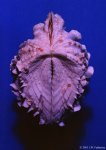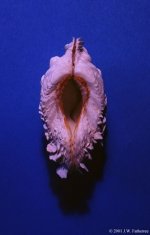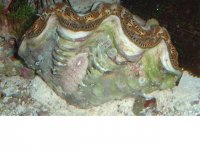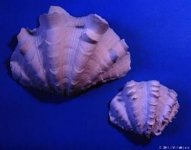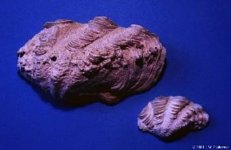You are using an out of date browser. It may not display this or other websites correctly.
You should upgrade or use an alternative browser.
You should upgrade or use an alternative browser.
Squamosa dying.
- Thread starter reefNewbie
- Start date
Based on some of the other pictures that clam is at least 3 or 4 inches. I've never seen or heard of a squamosa that size with a bysaal opening like that.
Looks pretty conclusive that it is a maxima to me and someone just doesn't want to admit they are wrong.
Heh, Nathan
Looks pretty conclusive that it is a maxima to me and someone just doesn't want to admit they are wrong.
Heh, Nathan
Okay, you dragged me back in one more time. 
While searching for pictures of byssus openings, I came across some additional info in The Reef Aquarium Vol. 1:
Too bad we can't see the incurrent aperture very well in either picture. Squamosa clams have "numerous, large, branched tentacles" that are easily distinguished from the "small, fine tentacles" of maxima clams. That's a sure distinguishing characteristic.
Maxima clams are typically "asymmetrical and elongated, 3x longer than broad." The pictured clam is more symmetrical, which is a characteristic of squamosa.
According to RA1, squamosa clams can be confused with maxima when small because they both can have scutes on their shells. "However, those of squamosa are much larger than those of maxima and are not as closely spaced." The scutes and spacing both indicate squamosa.
The byssus opening can be that of a juvenile squamosa. Actually, it appears more like a crocea from the bottom than either squamosa or maxima. The answer might be that it's a hybrid. Squamosa is "known to form hybrids with crocea and maxima."
Nathan: If you have facts to prove me wrong, please chime in. I welcome the education.
Greg
While searching for pictures of byssus openings, I came across some additional info in The Reef Aquarium Vol. 1:
Too bad we can't see the incurrent aperture very well in either picture. Squamosa clams have "numerous, large, branched tentacles" that are easily distinguished from the "small, fine tentacles" of maxima clams. That's a sure distinguishing characteristic.
Maxima clams are typically "asymmetrical and elongated, 3x longer than broad." The pictured clam is more symmetrical, which is a characteristic of squamosa.
According to RA1, squamosa clams can be confused with maxima when small because they both can have scutes on their shells. "However, those of squamosa are much larger than those of maxima and are not as closely spaced." The scutes and spacing both indicate squamosa.
The byssus opening can be that of a juvenile squamosa. Actually, it appears more like a crocea from the bottom than either squamosa or maxima. The answer might be that it's a hybrid. Squamosa is "known to form hybrids with crocea and maxima."
Nathan: If you have facts to prove me wrong, please chime in. I welcome the education.
Greg
The answer might be that it's a hybrid. Squamosa is "known to form hybrids with crocea and maxima."
Nathan: If you have facts to prove me wrong, please chime in. I welcome the education.
Actually I think I was the first to mention that it might be a hybrid a few posts back. :p
I don't have a copy of any of my books here at the office and I am leaving to go out of town tonight so I'll have to leave it to someone else to show you the error of your ways.
I'll leave you with a pic from one of the old aquarium frontiers articles by Knop that shows 2 maxima shells. One looks very similar to the shell of the clam in question here.
http://www.animalnetwork.com/fish2/aqfm ... photo1.asp
I actually stick by my first guess. It could be some type of a hybrid but it for sure isn't a squamosa. I think you lost that bet.
FWIW, Nathan
I'll leave you with a pic from one of the old aquarium frontiers articles by Knop that shows 2 maxima shells. One looks very similar to the shell of the clam in question here.
That picture actually supports my argument that the shell of the clam in question is atypical of maxima.
I don't have a copy of any of my books here at the office and I am leaving to go out of town tonight so I'll have to leave it to someone else to show you the error of your ways.
That's too bad. I was hoping you would take the time to educate me :wink:
Greg
Minh Nguyen":1li2pawy said:Tony,
Your picture shows a Maxima clam (less likely Squamosa) that is in very poor shape.....
Minh
GSchiemer":1li2pawy said:.....
BTW, that is a Tridacna squamosa clam. No doubt in my mind.
Greg
Greg,
Knowing evrything about the clam at this time, which is it is 4 inches long and the various view of the clam included the byssus opening. What is your ID of this clam now.
Minh
Minh,
I'm still leaning towards squamosa, but I can believe it was a hybrid. The picture of the byssus opening didn't change my mind because I don't have anything to reference it to. The shell shape and byssus opening actually looked more like crocea in those pictures. If it is maxima, it's atypical. As I said, if we could see the incurrent aperture, that would make identification easy. Unless he has a good picture from the top while the clam was alive, we won't learn anything new.
I think we've beat this horse to death. I enjoyed our exchange.
I enjoyed our exchange.
Greg
I'm still leaning towards squamosa, but I can believe it was a hybrid. The picture of the byssus opening didn't change my mind because I don't have anything to reference it to. The shell shape and byssus opening actually looked more like crocea in those pictures. If it is maxima, it's atypical. As I said, if we could see the incurrent aperture, that would make identification easy. Unless he has a good picture from the top while the clam was alive, we won't learn anything new.
I think we've beat this horse to death.
Greg
Greg,
You ID an 4 inches clam with this byssus opening as a Squamosa. I don't think you will find another person who know clams to agree with you. All I can said is that you are too good with clams and never have a Maxima or Squamosa died on you so you don't have much chance to look at their byssus opening.
Either that or you got one big ego.

Minh
You ID an 4 inches clam with this byssus opening as a Squamosa. I don't think you will find another person who know clams to agree with you. All I can said is that you are too good with clams and never have a Maxima or Squamosa died on you so you don't have much chance to look at their byssus opening.
Either that or you got one big ego.
Minh
Minh,
Apparently you haven't tired of this exchange as I have.
This has nothing to do with my ego. It's based upon the apparent facts. I admit to not knowing the average size of a byssus opening on a 4 inch squamosa clam, nor could I find a reference or picture that documents it. Do you have such information? If not, you've offered nothing to support your contention that it's a squamosa clam. In addition, the shell is spread wide open, which makes it difficult to judge the size of the byssus opening. I'm sure that even an real authority on Tridacnid clams would not commit to an identification based upon that picture. I made my judgement based upon the physical evidence (shell shape, size of scutes & distance of scutes) and referenced it to documented facts. If it turns out that it actually is a maxima clam, then it's certainly atypical of the species.
And, no I can proudly state that I haven't seen many dead clams. I understand that you have. The last clam that died under my care was a 15 year old crocea clam.
It's okay to admit that you might be wrong. Try it; it's refreshing.
Greg
Apparently you haven't tired of this exchange as I have.
This has nothing to do with my ego. It's based upon the apparent facts. I admit to not knowing the average size of a byssus opening on a 4 inch squamosa clam, nor could I find a reference or picture that documents it. Do you have such information? If not, you've offered nothing to support your contention that it's a squamosa clam. In addition, the shell is spread wide open, which makes it difficult to judge the size of the byssus opening. I'm sure that even an real authority on Tridacnid clams would not commit to an identification based upon that picture. I made my judgement based upon the physical evidence (shell shape, size of scutes & distance of scutes) and referenced it to documented facts. If it turns out that it actually is a maxima clam, then it's certainly atypical of the species.
And, no I can proudly state that I haven't seen many dead clams. I understand that you have. The last clam that died under my care was a 15 year old crocea clam.
It's okay to admit that you might be wrong. Try it; it's refreshing.
Greg
Greg,
Somebody foward this reference to me. You may want to tank a look at it.
Identifying the Tridacnid Clams by James W. Fatherree
http://reefkeeping.com/issues/2002-07/j ... /index.htm
In this articles, the folowing pictures was offered as ID characteristic of various clam species by the author.
I am glad that you learned something durring this exchange, even if you would not admit it.
I learned something about you too.
Cheer,
Minh
Somebody foward this reference to me. You may want to tank a look at it.
Identifying the Tridacnid Clams by James W. Fatherree
http://reefkeeping.com/issues/2002-07/j ... /index.htm
In this articles, the folowing pictures was offered as ID characteristic of various clam species by the author.
I am glad that you learned something durring this exchange, even if you would not admit it.
I learned something about you too.
Cheer,
Minh
Attachments
Minh,
We're going in circles now. The pictures don't address the size of the clams. As you know, the byssus opening gets smaller as Tridacna squamosa, T. gigas & T. derasa grow larger, until it all but disappears. If we used these pictures as a definitive reference, we'd conclude that the clam in question is T. crocea and we'd both be wrong.
I'm finished with this discussion. It's become boring and, unfortunately, it took an ugly turn thanks to you and "npnaden." In case you're unaware of it, most people find it offensive when someone says:
We're going in circles now. The pictures don't address the size of the clams. As you know, the byssus opening gets smaller as Tridacna squamosa, T. gigas & T. derasa grow larger, until it all but disappears. If we used these pictures as a definitive reference, we'd conclude that the clam in question is T. crocea and we'd both be wrong.
I'm finished with this discussion. It's become boring and, unfortunately, it took an ugly turn thanks to you and "npnaden." In case you're unaware of it, most people find it offensive when someone says:
Either that or you got one big ego.
Greg,
In no way I am ignored anything. When we ID a clam, we got to consider all the characteristics that are available, realizing that some are definitive than others are not. I point out the byssus opening pictures because the byssus opening is the definitive characteristic. We should not get hook on one ore two minor points and ID the clams on these minor points. I used all of available characteristics and ID the clam while you was so sure of yourself using only one minor one. Let me point out your first post in this thread ID this clam only from the picture of the dying clam. You did not have the benefit of the others pictures to help in ID this clam at the time.
"...BTW, that is a Tridacna squamosa clam. No doubt in my mind."
Once Tony shows the picture of the byssus opening of this clam, there can be no doubt of the species of the clam. You are wrong when you ID this clam. I agree completely that the shape of the shell is somewhat atypical for the species. This is very common for Maxima. Regardless, it is a Maxima from the byssus opening size.
I don't want to imflame this anymore so let just quit.
Minh
In no way I am ignored anything. When we ID a clam, we got to consider all the characteristics that are available, realizing that some are definitive than others are not. I point out the byssus opening pictures because the byssus opening is the definitive characteristic. We should not get hook on one ore two minor points and ID the clams on these minor points. I used all of available characteristics and ID the clam while you was so sure of yourself using only one minor one. Let me point out your first post in this thread ID this clam only from the picture of the dying clam. You did not have the benefit of the others pictures to help in ID this clam at the time.
"...BTW, that is a Tridacna squamosa clam. No doubt in my mind."
Once Tony shows the picture of the byssus opening of this clam, there can be no doubt of the species of the clam. You are wrong when you ID this clam. I agree completely that the shape of the shell is somewhat atypical for the species. This is very common for Maxima. Regardless, it is a Maxima from the byssus opening size.
I don't want to imflame this anymore so let just quit.
Minh




